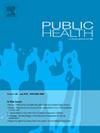工作场所二手烟暴露及其与呼吸道症状的关系:2015-2020年横断面调查结果
IF 3.2
3区 医学
Q1 PUBLIC, ENVIRONMENTAL & OCCUPATIONAL HEALTH
引用次数: 0
摘要
目的研究在无烟区扩大(包括2007年以来香港所有室内工作场所)8年多后的2015年至2020年,工作场所二手烟暴露(SHS)的流行情况及相关因素,以及其与中国成年人呼吸道症状的关系。研究设计:基于人群的调查。方法选取2015-2020年6次随机数字电话调查13048名年龄在15岁以上的在职调查对象。收集了有关社会人口因素、吸烟状况和工作场所SHS暴露的信息。随机选择4585名受访者报告其最近的呼吸道症状。结果24.8%的调查对象在调查前7天报告了工作场所暴露于SHS的情况。男性、年龄较大、受教育程度较低、户外工作、室外和室内工作、车辆工作、服务和销售人员以及体力劳动者与工作场所的SHS暴露有关(所有P <;0.05)。工作场所暴露于SHS与从不吸烟者(调整患病率比(APR) 1.34, 95%可信区间1.00至1.81)和戒烟者(APR 1.34, 95%可信区间1.02至1.77)的呼吸道症状相关,并存在剂量-反应关系。结论在所有室内工作场所禁烟8 ~ 13年后,工作场所SHS暴露在室外职业中普遍存在。从不吸烟者和已戒烟者在工作场所暴露于二手烟与自我报告的呼吸道症状有关。政策制定者应考虑不断将无烟区扩大到更多的户外公共场所。本文章由计算机程序翻译,如有差异,请以英文原文为准。
Workplace second-hand smoke exposure and its association with respiratory symptoms: Findings from cross-sectional surveys 2015–2020
Objectives
We investigated the prevalence and associated factors of exposure to secondhand smoke (SHS) at workplaces from 2015 to 2020, 8+ years after the expansion of smoke-free areas, including all indoor workplaces in Hong Kong since 2007, and its association with respiratory symptoms in Chinese adults.
Study design
Population-based survey.
Methods
13,048 working respondents (aged 15+ years) from 6 waves of population-based random-digit telephone surveys (2015–2020) were included. Information on sociodemographic factors, smoking status, and SHS exposure at workplaces were collected. 4585 respondents were randomly selected to report their recent respiratory symptoms. Log-binomial regressions assessed factors associated with SHS exposure at workplaces and the association between SHS and respiratory symptoms, adjusting for sociodemographic factors.
Results
24.8 % of respondents reported SHS exposure at workplaces in the 7 days preceding the survey. Male, older age, lower education level, work outdoors, work both outdoors and indoors, work in vehicles, work as service and sales workers, and work as manual laborers were associated with SHS exposure at workplaces (all P < 0.05). SHS exposure at workplaces was associated with respiratory symptoms in never smokers (Adjusted prevalence ratio (APR) 1.34, 95 %CI 1.00 to 1.81) and ex-smokers (APR 1.34, 95 %CI 1.02 to 1.77), with dose-response relationships.
Conclusion
Eight to thirteen years after banning smoking at all indoor workplaces, SHS exposure at workplaces was prevalent in outdoor occupations. Exposure to SHS at workplaces was associated with self-reported respiratory symptoms in never and ex-smokers. Policymakers should consider continuously expanding smoke-free areas to more outdoor public places.
求助全文
通过发布文献求助,成功后即可免费获取论文全文。
去求助
来源期刊

Public Health
医学-公共卫生、环境卫生与职业卫生
CiteScore
7.60
自引率
0.00%
发文量
280
审稿时长
37 days
期刊介绍:
Public Health is an international, multidisciplinary peer-reviewed journal. It publishes original papers, reviews and short reports on all aspects of the science, philosophy, and practice of public health.
 求助内容:
求助内容: 应助结果提醒方式:
应助结果提醒方式:


